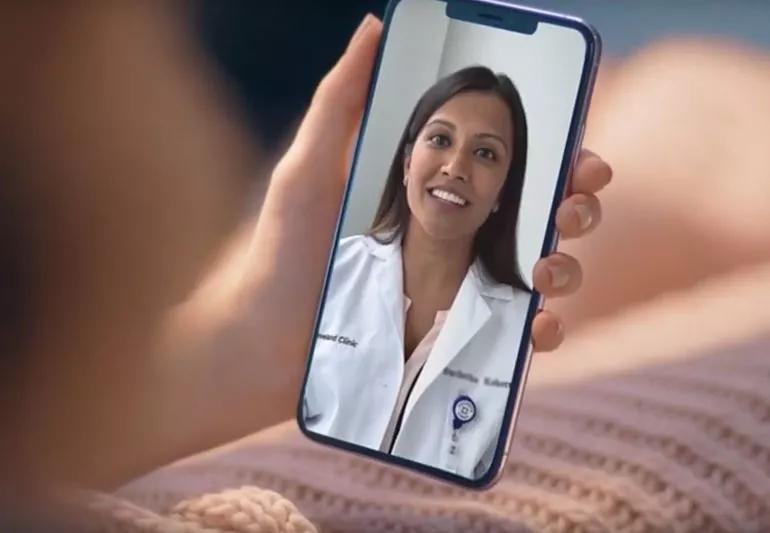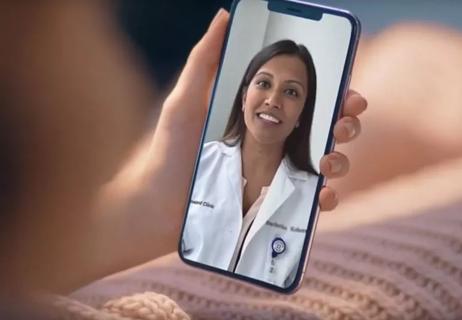Telehealth appointments have improved access to medical care

COVID-19 made a huge impact worldwide that will perhaps be felt for decades. But out of that chaotic time, we took some positive steps when it comes to improving access to quality healthcare. What was once considered a mandatory tool to reduce the spread of infection, virtual visits and telemedicine consultations are here to stay as an option that’s available for all individuals interested in receiving care for their mental and physical health without having to leave their home and come into an office.
Advertisement
Cleveland Clinic is a non-profit academic medical center. Advertising on our site helps support our mission. We do not endorse non-Cleveland Clinic products or services. Policy
“People are thrilled they have this ability to access healthcare,” says family medicine doctor Mark Rood, MD. “We can use virtual appointments as a conduit to get people into a brick-and-mortar center for primary care and specialty care, or we can develop a pure virtual relationship to allow for faster access to care than perhaps they might have if they were to try and get an appointment in the office.”
For people who are immunocompromised, live farther than they’d like from a hospital setting or for people who have difficulty leaving their homes, virtual appointments can be lifesaving alternatives. And in particular, more and more people are using virtual appointments in place of in-person therapy and general primary care as a means of improving and maintaining their physical and mental health.
“People often assume that to get their mental healthcare needs met, they need to start with a psychiatrist, or psychologist, but primary care physicians are often the first point of contact for people with a mental health condition,” clarifies Dr. Rood.
“Being able to see someone in the comfort of their own home, with or without the support of their family around them, is an advantage that we are also provided in the virtual space that we aren’t provided in an in-person setting.”
Advertisement
If you’ve never had a virtual appointment or wonder how they’ve changed since they were first offered during the pandemic, we’ve got you covered. Dr. Rood provides some tips for making the most out of your virtual appointments and an explainer on what you can expect.
Early on, these terms were used to identify different uses of digital technology within the medical field. Now, they’re used interchangeably to describe the use of digital technology to deliver and improve access to healthcare for anyone who needs it.
Most insurance companies cover at least some form of virtual healthcare or telehealth services, and may require a copayment for each visit. You can also schedule a virtual appointment with any healthcare provider at any institution who performs virtual visits, as long as they have a medical license for the state in which you’re in at the time of your appointment.
“Virtual visits are often the most cost-effective way to receive care,” says Dr. Rood. “We can treat lots of nonemergency problems virtually.”
Online, caregivers can provide consultation to people who have a number of express care concerns and injuries. These conditions include:
They’re also able to provide consultations for any common primary care chronic conditions or mental health conditions, including:
For virtual visits, you’ll need to have access to the internet and a computer, tablet or smartphone. In some cases, healthcare providers might allow the option of using the telephone without video for your appointments, but most virtual appointments use video in some way.
The reason for this is because your healthcare provider may want to do a visual exam and look you over for rashes or other physical abnormalities. Sometimes, your provider may recommend that you make a follow-up appointment for an in-person test or exam, like getting your blood drawn, getting a sleep study or having a strep test, but this happens only when it’s most necessary. In most cases, for general, nonemergency primary care, a majority of virtual visits can be held entirely on the phone or through a smart device.
Before your virtual appointment, you’ll want to:
Advertisement
Depending on where you’re receiving care, each individual institution may have their own app with varying features. But the general idea is to improve your user experience and minimize the sometimes-complicated process of getting medical attention and treatment.
“We’re not constrained by needing a physical space, we’re not constrained by the time it takes for a medical assistant to check you in, and there’s no travel time and no traditional waiting room with virtual visits,” says Dr. Rood
Companion apps like MyChart also offer a secure means of accessing your medical record. You can use these apps to keep track of your appointments and access test results, visit summaries and commonly asked questions.
You can also use these apps to send messages back and forth with your healthcare provider for any last-minute questions you have, to request refills on prescriptions and to schedule future appointments. This is especially helpful for people who are managing ongoing, chronic health conditions like high blood pressure, heart disease, diabetes and arthritis and need healthcare providers to monitor their symptoms or adjust their medication without ever having an in-person visit. And while there may be a nominal charge for this type of care, it’s relatively inexpensive when compared to an in-person visit.
Advertisement
“It’s worth talking to your primary care doctor or specialist to see if they can perform a virtual visit,” Dr. Rood encourages. “We can help our patients monitor their chronic conditions remotely.”
And between visits, you can even buy devices to use at home to measure your heart rate, blood pressure and weight. Some smart devices automatically upload the data to your medical chart for your provider to review, making that process even more manageable.
“Technology has really advanced in the past two or three years to allow us to do things we’ve never done before,” Dr. Rood notes.
Just because you’re meeting with your healthcare provider over the screen doesn’t mean it has to be quick, cold or chaotic. Healthcare providers who offer virtual visits are able to give the same level of quality care you would receive if you were to come into an office in-person.
Plus, there are a few things you can do to ensure these virtual visits go as smoothly as possible. Here are some helpful tips from family medicine specialist Neha Vyas, MD:
Advertisement
“By design, virtual appointments help people get the care they need in the timeliest way possible,” emphasizes Dr. Rood.
Etiam sed dui enim. Aliquam blandit metus sit amet viverra placerat. Sed egestas varius neque. Fusce porta turpis et pharetra tincidunt. Curabitur malesuada auctor est et commodo
Etiam sed dui enim. Aliquam blandit metus sit amet viverra placerat. Sed egestas varius neque. Fusce porta turpis et pharetra tincidunt. Curabitur malesuada auctor est et commodo
Etiam sed dui enim. Aliquam blandit metus sit amet viverra placerat. Sed egestas varius neque. Fusce porta turpis et pharetra tincidunt. Curabitur malesuada auctor est et commodo
Learn more about our editorial process.
Advertisement

Telehealth appointments have improved access to medical care

Bleeding is a risk and warrants taking care, but the reward of this lifesaving medication is great

Severe and debilitating headaches can affect the quality of your child’s life

With repeat injections over time, you may be able to slow the development of new wrinkles

Although it can be alarming, it’s normal to experience blood clots during menstruation

Type 2 diabetes isn’t inevitable with these dietary changes

Applying a hot or cold compress can help with pain